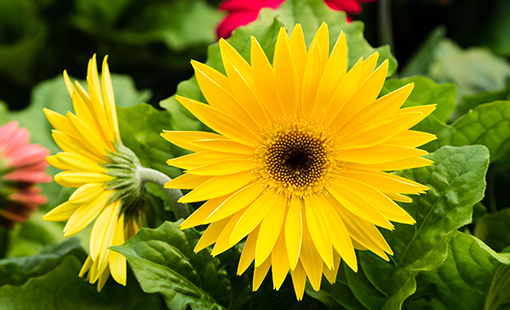
Gerbera Daisies Info & Care
If you’re thinking of growing your own gerbera daisies, these lovely flowers have probably caught your eye at the flower shop. It’s hard to resist their broad-face blooms in vivid, captivating colors. Their long naked stems only add to the bloom’s visual appeal.
Gerbera daisies, also called Transvaal or Barberton daisies, are not difficult to grow at home, but they do require patience; these are slow-growers can take 18-24 weeks from planting to bloom. They grow as perennials in zones 9- 11, but elsewhere you have to be resigned to annual planting, or grow them in pots outdoors and bring them in for the winter (they don’t like transplanting). You can get to bloom time earlier in summer if you start them from seed indoors, up to 8 weeks before the last frost.
The famously colorful blooms of gerbera daisies are large (4 inches across) and have a central disk that can be yellowish, light-bronze, or dark in color. This disk is surrounded by rays that come in a variety of hues. The blooms of the species plants are most commonly yellow, red, or orange, but there is a large variety of cultivars that produce a range of colors, including amber-orange, lavender, pink, salmon and white. In addition, gerberas come in four classes, based on the flower type and the arrangement and quantity of petals: single-flower, semi-double flower, double flower and spider flower.
Care
Gerbera daisy flowers are grown as perennials in planting zones 9-11. Elsewhere, they are treated as annual plants.
To cut flowers for display, harvest them when the centers are tight and the petals are fully open. Place the cut stems in a vase with no more than about 1 inch of water. The straw-like stems will suck up water to the detriment of the flowers. But since you’re adding so little water, keep an eye on the vase so it doesn’t dry out. If necessary, trim any discoloration at the bottom of the stem, using an angled cut from clean garden shears.
Light
Grow gerbera daisies in full sun to partial shade. More sun is better in cooler climates; less sun is better in hot areas.
Soil
Gerberas do best in well-drained soil enriched with compost. Sandy soil is ideal for these lovers of sharp drainage. A soil pH of 5.5-6.5 is ideal. Leaves with yellow stripes indicates chlorosis, due to alkaline soil. Soil that’s too acidic may lead to black spots on the leaves.
Water
Gerberas typically need 1 inch of water per week. Wait until the soil is dry before watering. Overly wet soil can lead to crown or root rot, as well as powdery mildew. Avoid overhead water for the same reason. Keep a close eye on seedlings, which may need more frequent watering. Water only once a month during winter (in areas where gerberas grow as perennials), when the plants go dormant.
Temperature & Humidity
These daisies are sensitive to both frost and intense heat. They overwinter well in temperatures between 45 and 50 degrees Fahrenheit. To prevent overheating, keep them away from hot microclimates, such as areas next to foundations or brick walls.
Fertilizer
Fertilize monthly with an all-purpose, water-soluble fertilizer for the best blooming display. Alternatively, you can keep the plants fed by topdressing the soil with organic compost.
Pruning
Deadhead gerbera daisy blooms to promote additional flowering; remove dead leaves as needed. No additional pruning is necessary.
Propagating Gerbera Daisies
Gerberas can be propagated with clippings. To do so, fill small (3-inch) containers with potting mix. Clip stems just above the soil level—stems should be about 6-inches long—and dip the ends in rooting hormone. Insert stem into potting mix, and spray with water to dampen. Place pot in a plastic bag, to keep the soil moist, and keep in indirect sunlight. Spray daily until stem takes root, transplant to larger containers and move outside come spring.
Overwintering
In zone 8, some homeowners report success in growing them as perennials, especially if garden mulch is used to protect against winter cold. However, be sure not to allow mulch to cover the crown, since this plant is susceptible to crown rot.
Common Pests & Diseases
Gerbera daisies fall prey to aphids, whiteflies, thrips and spider mites. Checking the leaves once in a while for bugs should be part of a regular care regimen. If you find an infestation, spray with neem oil.
Information courtesy of TheSpruce.com

 Adams Fairacre Farms
Adams Fairacre Farms